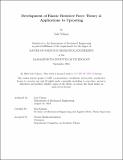| dc.contributor.advisor | Kamrin, Ken | |
| dc.contributor.author | Yilmaz, Lale | |
| dc.date.accessioned | 2024-10-09T18:27:59Z | |
| dc.date.available | 2024-10-09T18:27:59Z | |
| dc.date.issued | 2024-09 | |
| dc.date.submitted | 2024-09-25T15:57:30.683Z | |
| dc.identifier.uri | https://hdl.handle.net/1721.1/157201 | |
| dc.description.abstract | Granular intrusion processes such as sand locomotion, uprooting, and digging are commonly present. While these phenomena can be accurately modeled via discrete element methods and continuum models, this accuracy comes at a great computational cost, especially for large systems. Granular Resistive Force Theory (RFT) is a reduced-order, rateindependent model that has been shown to successfully capture the motion of rigid intruders in granular media, with a reduced computational cost. RFT is based on a rate-independent theory that calculates the force experienced by a body using its direction of velocity. This makes it difficult to handle scenarios that are near-stagnant which occur frequently in uprooting of plants. To overcome this limitation, we introduce elastic RFT (eRFT) which is based on a rate-independent plasticity flow-rule–like criterion, and pair it with deformable intruders. We focus on modeling uprooting processes which inherently have flexible intruders and are often dynamically controlled. This allows us to address both previously mentioned shortcomings of RFT (stagnancy and flexible intruders) at once. By combining eRFT with a nonlinear beam theory to represent slender, inextensible roots we create a speedy computational tool. Using MATLAB, we simulate various uprooting scenarios to better understand anchoring mechanisms of different root geometries. We showcase the validity of eRFT results by comparing them to experimental data. To implement eRFT in ABAQUS, we make use of an existing user subroutine which allows the study of a broader range of intruder materials and shapes. While the subroutine has its limitations, initial comparisons to computational and experimental results are demonstrative. | |
| dc.publisher | Massachusetts Institute of Technology | |
| dc.rights | Attribution-NonCommercial-NoDerivatives 4.0 International (CC BY-NC-ND 4.0) | |
| dc.rights | Copyright retained by author(s) | |
| dc.rights.uri | https://creativecommons.org/licenses/by-nc-nd/4.0/ | |
| dc.title | Development of Elastic Resistive Force Theory & Applications to Uprooting | |
| dc.type | Thesis | |
| dc.description.degree | S.M. | |
| dc.contributor.department | Massachusetts Institute of Technology. Department of Mechanical Engineering | |
| mit.thesis.degree | Master | |
| thesis.degree.name | Master of Science in Mechanical Engineering | |
